|
April 22nd 2015 Benitses
Just 20 minutes from town by bus, Bentises out of season is quite dead; which may be a positive. There's actually not to much to do here, but we did see the remains of the Roman bath house. My notes indicated that behind the village there is open country, which may yield some orchids, but a look at the hinterland rising steeply made this a bit of a daunting prospect. We headed inland by the only `street' and then just followed the way. Eventually we did spot a few purple spikes at the entrance to some flat open ground, which revealed a number of orchids. The ground actually seemed to have been quite wet until recently, and at one point was still boggy.
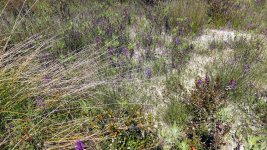 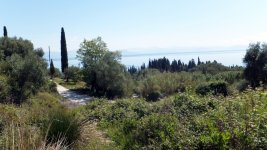
The most obvious orchid there was Orchis laxiflora, present in all parts of the spot. These were easily identified by the labellum folded almost in half and the erect sepals and petals giving the flowers an almost 2D appearance. Also present were some Serapias plants, tentatively identified as Serapias bergonii. Finally, and in the damper parts there was a few Ophrys, perhaps a bit past their best. From slenderness of the plant, the bumps on the labellum, the overall paleness (especially the petals and sepals), and the speculum markings I am inclined to think these were Ophrys grammica which is known from Corfu and the neaby mainland.
   
O. laxiflora S. bergonii
 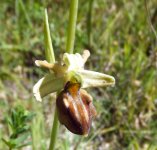 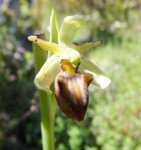
O. grammica
22nd April 2015 near Corfu Town
Part of the holiday plans were to see some of the archeological attractions of Corfu. Unfortunately, and probably due to the Greek debt crisis, all the sites and the museum were closed to the public. We could see some of the sites over the fences though, including the Temple of Artemis in Paleopolis. Apart from the stones and stuff, there were loads of O. laxiflora visible from the road
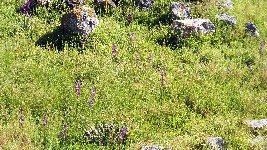
23rd April 2015, Ipsos, Pyrgi and Dassia
During our previous stay in Corfu we had seen numerous orchids at the roadside or in the countryside in this area. I was in for a disappointment. The bit of ground outside Pyrgi which was home to Serapias and A. pyramidalis was now a tarmaced drive to a hillside villa. Along the road to Analipsis we had seem Ophrys lutea, O. sphegodes, O bombilifera, A. pyramidalis and O. morio. Now the road was all built up. We had taken a walk across fields from here and seen O. morio, O. laxifera, S. lingua and S parviflora. The path had disappeared or was closed off. The main road to Dassia boasted O. morio, O. laxifera, and S. lingua. Again it was built up or fenced off. The path down to the beach at Dassia had O. morio, O. laxifera, and O. sphegodes. Now only some O. laxiflora can be seen, again behind fences. Only along the road from Ipsos going inland past the `town hall' were any orchids approachable. There were O. laxiflora and S. vomeraceae
  
24th April 2015, near Spartilas
A hire car was needed to try and cover the orchids on the slopes of Pantokrator. Its quite drive up to the fist village, Spartilas, with 27 hairpin bends. Just past there was the first notable site, where one could park safely. We were above the level where it was now deemed necessary to fence off the land. Quite a nice array of orchids were found on some sloping ground under olive trees at an altitude of 450m.
There were O. italica and Orchis picta (morio) in typical, pale and deeper coloured forms. I am prepared to put this label on these based on O. picta being found on Pantokrator, the denser and more pyramidal inflorescence, and the shorter central lobe on the labellum. Like earlier, the Barlia robertiana here were finished with flowering. The yellow bee orchids seem to fit the description of Ophrys sicula - the labellum is more deeply incised than O. lutea, bent up a bit at the end, not bent down towards the base and without ridges. These could be found growing in numbers along the roadside. Also present was a species I have tentatively as Ophrys attaviria, which has no basal ridges on the labellum unlike O. fusca. This was at the end of its flowering period.
    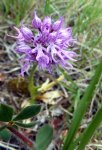
O. picta O. italica
 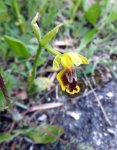  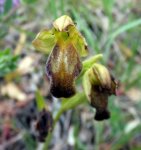
B robertiana O. sicula O. attavira .
Higher up on Pantokrator at around 800m the flora was a bit different. There were still some Ophrys sicula in groups. Rather spectacular were Man Orchids, Aceras antropophorum. The were growing among the rocks on the slopes above the road in significant numbers. But what drew us to stop at this spot was a number of purple flower spikes which turned out to be Orchis quadripunctata. These were the orchids in the greatest numbers. Opposite to this was one single solitary Monkey Orchid, Orchis simia.
    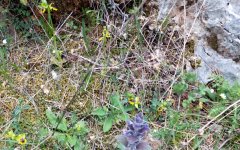
A. anthropophorum O. sicula
  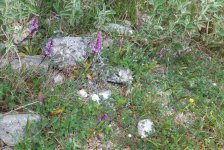 
O. quadripunctata
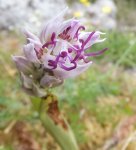 
O. simia
It was at this point we had to change our plans for the day. It had stated off as a grey day, but as we were about to head for the summit the clouds came down, and visibility fell to about 10 foot at times. The roads there are rocks on one side, and a big drop on the other, so we needed to descend as and when the clouds allowed. Below is a picture taken at this site and another of Pantokrator from Ipsos a bit later.
24th April 2015 Northern Corfu
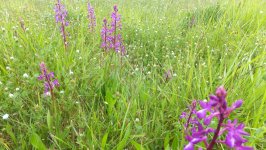  
As you drive around the northern end of the island (and probably the middle and the south) you will see fields with O. laxiflora poking out above the vegetation. The third picture above shows a rather tall example that reached waist height, growing at the side of the road.
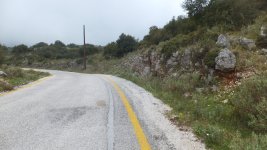 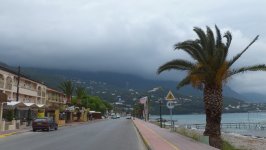
24th April 2015 near Sidari
Research had suggested that various Serapias grew around Sidari, but arriving there it became obvious that "around" covered a large area. So we set off again hoping to spot suitable sites from the car. A mile or two outside Sidari provided such a site, with orchids growing each side of the road in the verges.
Most obvious were more O. laxiflora. There was also some Serapias vomeracea and Ophrys lutea. A species new to the holiday was the Bug Orchid - Orchis fragrans. I hang my head in shame that I didn't try to smell this flower. The was also some Ophrys species well past its sell by date. Look close at the top desiccated example of a flower. Looks like O. fusca to me.
   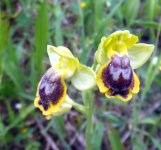 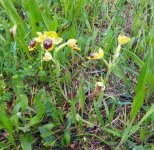
O. laxiflora S. vomeracea O. lutea .
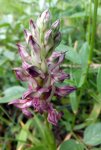  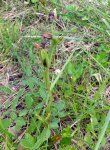
O. fragrans unknown .
24th April 2015. An Olive Grove
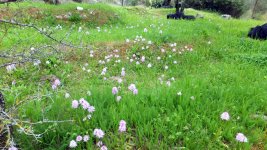 We took the road from Roda direct to Pyrgi along the foothills of Pantokrator, marked on my map as a red route. We had traveled the southern end previously, but at the other end it was single track, had potholes from hell to avoid, and landslips across the tarmac. We made slow progress. Along here was an unfenced olive grove that advertised its orchids with a mass of pink blooms and was home for the typical orchid flora of the area. We took the road from Roda direct to Pyrgi along the foothills of Pantokrator, marked on my map as a red route. We had traveled the southern end previously, but at the other end it was single track, had potholes from hell to avoid, and landslips across the tarmac. We made slow progress. Along here was an unfenced olive grove that advertised its orchids with a mass of pink blooms and was home for the typical orchid flora of the area.
By far the most noticeable orchids were O. italica. They grew in swarms, often with O. morio. It didn't take much searching to find several other species.
Ophrys was represented by O. lutea, O. bombilifera and two others which have given me a bit of a headache trying to identify. They share a number of features and there are at least four species which make reasonable candidates. All grow on Corfu, have pale sepals and petals, H shaped speculums, and two lateral swellings on the labellum. Based on the overall form of the plants, sepal colouration and comparing labellum shape I favour them as O. grammica and O. cephalonica. I am reluctant to count them as the same species. Though found in the same area, the two grew on opposite sides of the road and about 150 metres apart, one on a slope under trees (O. grammica) and the other on flat ground in full sun in a clearing (O. cephalonica). O. grammica was a single plant and the top broken off, but O. cephalonica was a tall lax-flowered robust plant.
One oddity was found. Was it an O. lutea unfurling its sepals and petals, or was it, from the overall appearance, a hybrid of that species with O. bombilifera?
Also present were Serapias lingua, S. parviflora, Anacamptis pyramidalis and a couple of unopened inflorescences which may have been late flowering O. italica, but the pinkish colouration leant towards a more purple shade than that species. Attempts to unravel a single flower was inconclusive with the labellum remaining compact. I believe these to be Orchis tridentata, from the colour, the striped sepals and the coloured dots visible on the labellum. What does not match is that these specimens have spotted stems, but no other species fits as well.
   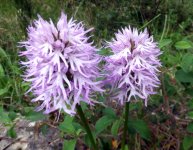 
Orchis italica Orchis morio .
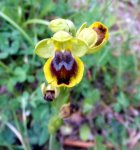 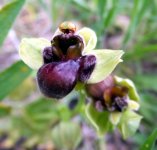 
Ophrys lutea Ophrys bombilifera Ophrys grammica
 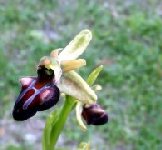 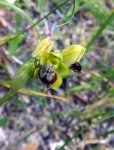
Ophrys cephalonica ? Ophrys hybrid
 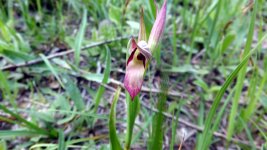  
Serapias lingua S. parviflora A. pyramidalis
 
Orchis tridentata
    
|
